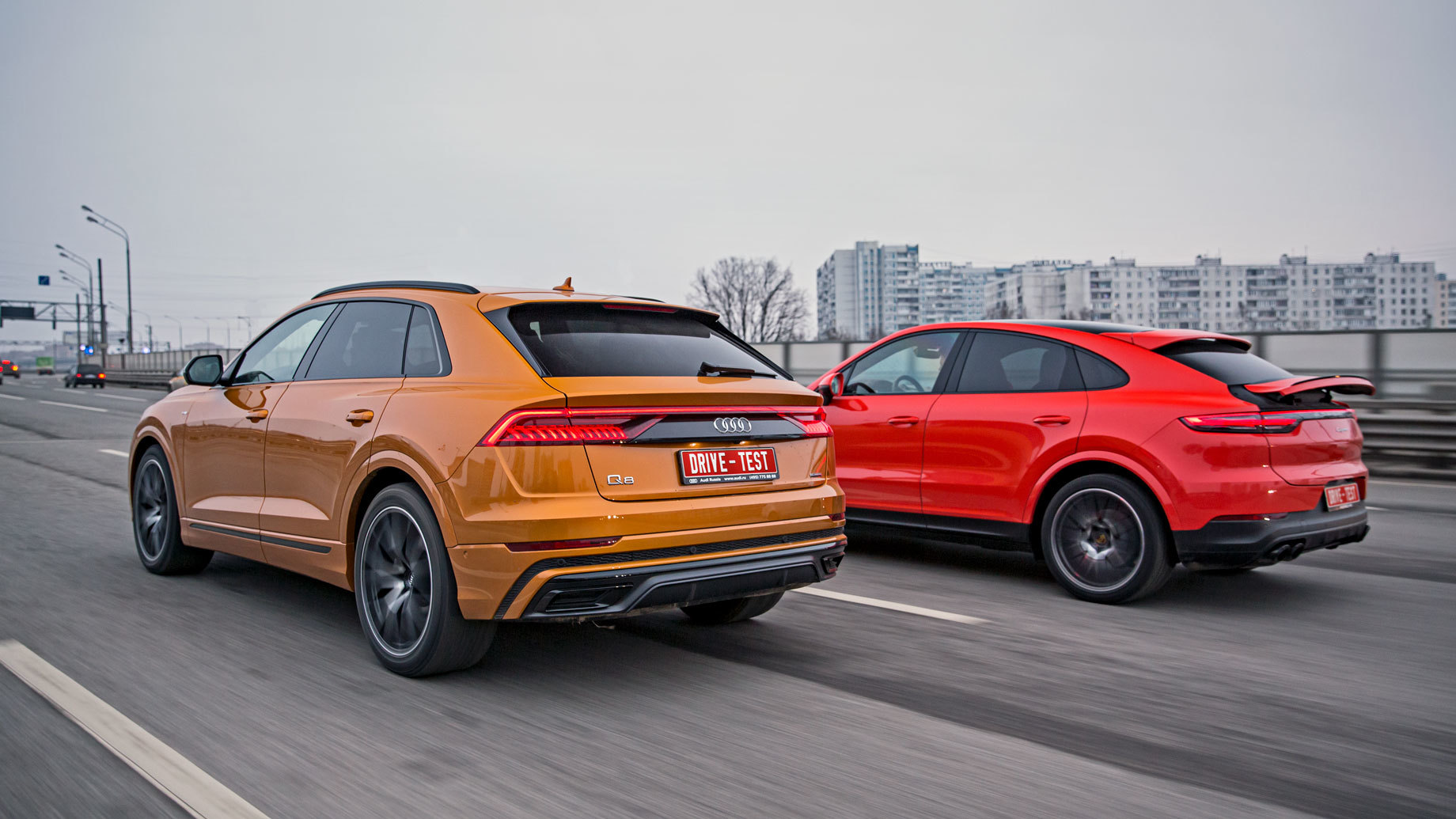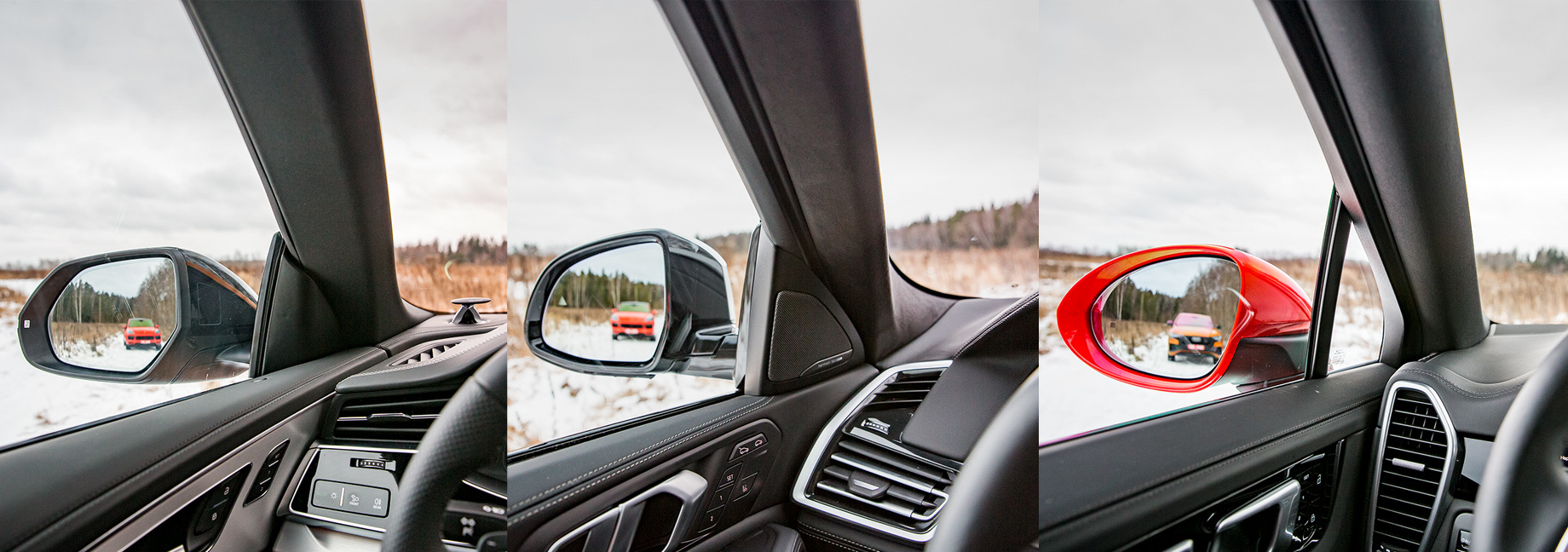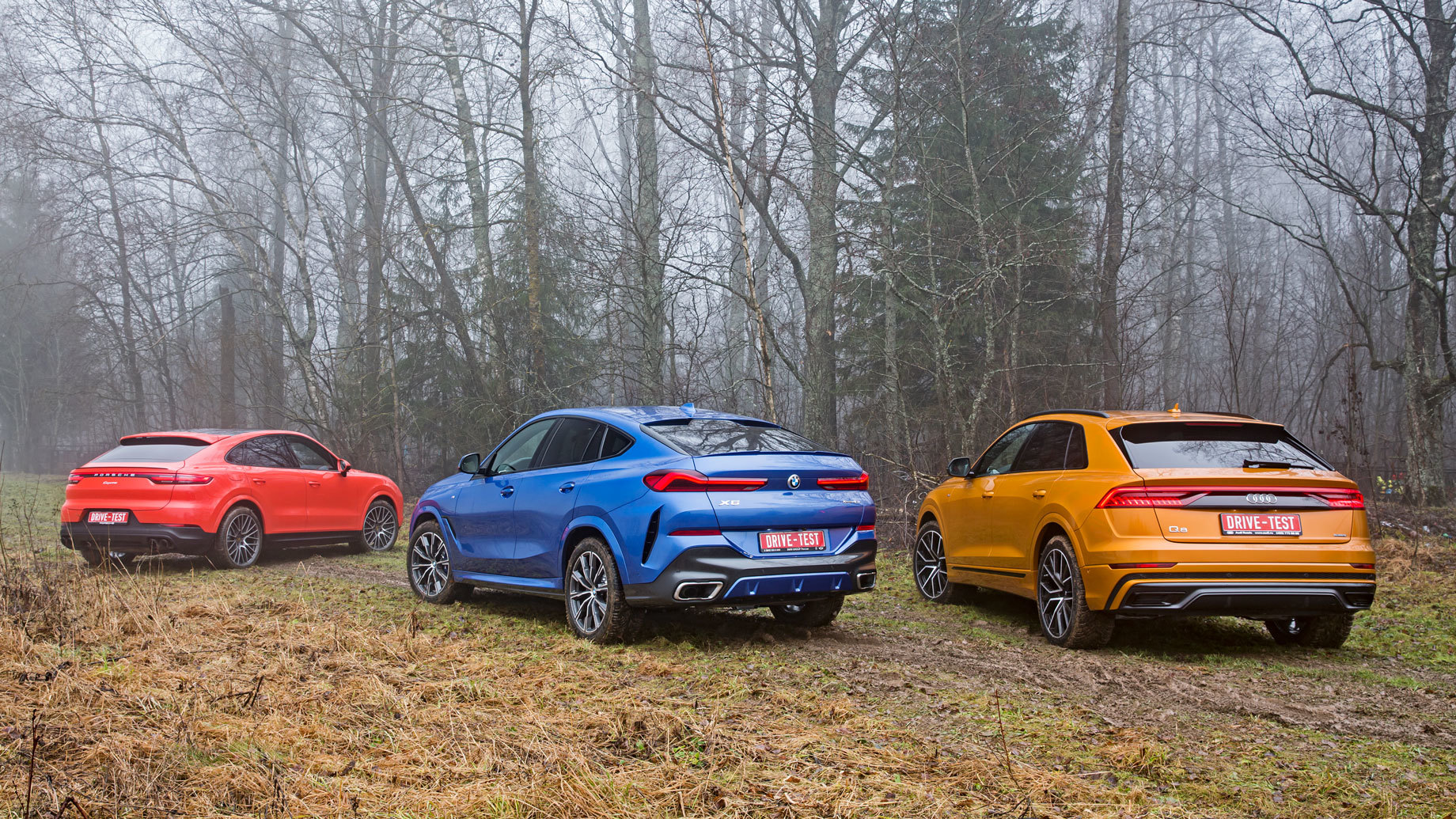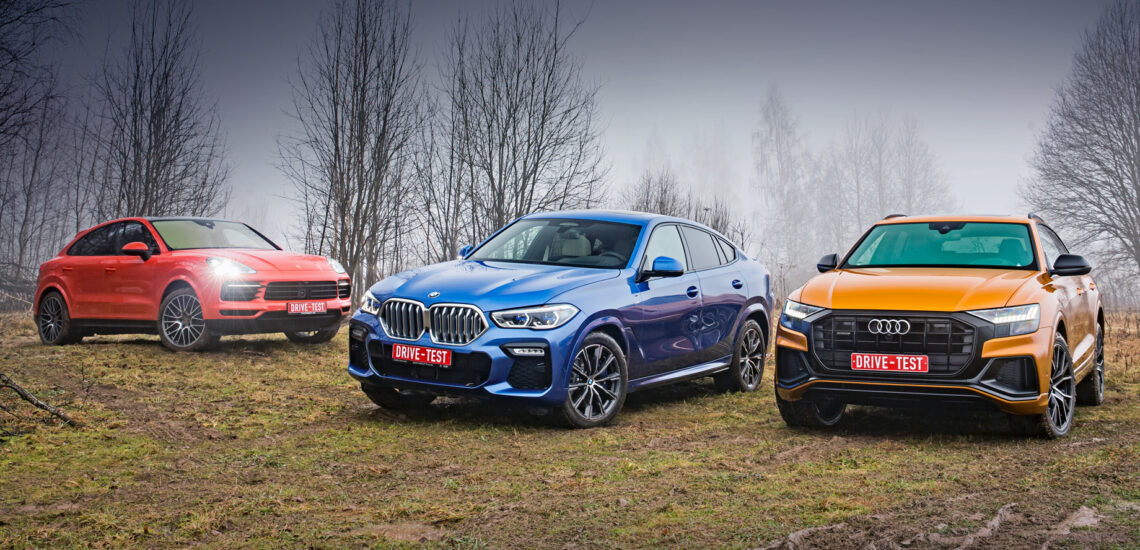In just over a year, the market of expensive fashion cross hatches has been completely updated. Only the Mercedes GLE Coupe did not have time for this test. From the press parks of Audi and BMW, we drew out both the most sought-after diesel versions for comparing the Q8 and X6, and gasoline ones to figure out for three. After all, Cayenne Coupe does not work on diesel fuel…
Porsche is most often bought with a three-liter V6 engine (340 hp, 450 N•m). The same platform Audi Q8 55 TFSI is equipped with an identic one, but developing 50 N•m more. And from the inline “six” 3.0, the BMW X6 xDrive40i has the same amount removed as in the Cayenne. In the diesel standings, the inputs are also extremely close: with an identical power of 249 hp, the six-cylinder Q8 45 TDI and BMW X6 xDrive30d produce 600 N•m and 620 respectively. All cars in the test use the same eight-speed ZF 8HP series automatic gearbox.

At the same time, the Q8 in the initial configuration is cheaper than its competitors, regardless of the motor. Although, the front bumper is devoid of parking sensors, and the simplified multimedia complex is devoid of navigation. The steering tube is mechanically adjustable, the seats are trimmed with fabric and leatherette. The Cayenne Coupe, for sure, is the most expensive. In the basic configuration it offers a combination with leather, knee pads, a rear camera and a panoramic roof. The steering wheel also moves manually.
The average price tag of a base BMW is justified by adaptive laser headlights, leather upholstery, servos, driver’s seat memory settings, heated steering wheel and front door armrests. With the addition of obvious excesses, the test X6 is not inferior to its competitors in terms of functionality. All cars are equipped with air suspension, but only the Cayenne and the Q8 allow it to be combined with a fully controlled chassis.
Audi and BMW hatchbacks stylistically clearly distance themselves from the Q7 and X5 station wagons. You need to take a closer look at the Porsche: whether it is a Coupe or a regular Cayenne. But it’s better than originality at any cost, as in the case of the X6. Beauty is lost in the folds of the heavy upturned stern. The bet is made on a kitschy illuminated radiator grille. Audi not only puts on a light show when unlocking, but also flaunts doors without window frames. For Cayenne, the main thing is not to be seen with a raised spoiler.
The door-covered sills of the Q8 and Cayenne are always clean, although in a Porsche you can get dirty on the way to the back row, hitting the arch. And in the X6 all visitors have to be careful — its sills are outside. The rear passengers of all three cars are not deprived of space. In Audi, however, the ceiling is higher, and there is more space in the knees. In addition, the Q8 allows you to move the backseat in parts and adjust the angle of the backrest. But the X6 has the most compact central tunnel.

Ergonomically, BMW is closer to me, where touch control of secondary functions harmoniously coexists with physical buttons. There is only one nuance. If you lower the seat as much as possible and pull the column down to the limit, the steering wheel still turns out to be a bit high. In the X5, that we recently tested, the geometry and adjustment ranges are better suited to short drivers like me (5’6).
Related Audi and Porsche oblige to use touch panels, which is not very convenient and sometimes unsafe on the go. Cayenne surprises at all with the inability to switch tracks or radio stations from the steering wheel. Achieving an optimal fit in the firm Porsche sports seats is easy, but they are cramped for my dense body. In the Q8, as in BMW, I sit more freely.
There is enough gloss in the X, but you rarely use the buttons located on the shiny central tunnel. You can not touch the large touchscreen at all: it’s still more convenient to use the puck-controller in motion. Or even use gestures. Thus, the X6 is easier to keep organized, and the perception of quality in the cabin is less dependent on the amount of dust and fingerprints.
It is easier to find a common ground with BMW powertrains. The petrol one immediately makes a good impression with responsiveness. Even in comfort mode, it willingly obeys any, albeit subtle, accelerator commands. The sports program further enhances sensitivity, without turning the crossover into a neurotic. The traction control is convenient! An overly pointed Sport + is not needed: every pedal movement causes a jerk.

The gearbox shifts quickly and smoothly, but not seamlessly: gear changes are always noticeable. Paired with a gasoline engine, it has to actively shuffle gears. Less hassle with a diesel. Despite the fact that according to the passport, the xDrive30d is gaining 60 mph a second longer than the petrol one (in 6.5 s versus 5.5 for the 40i), it makes an even more pleasant impression. Crowbar traction from the bottom provides an absolutely relaxed start and assertive acceleration within the same step. And the in-line turbodiesel sounds unexpectedly pleasant.
The voice of the Audi TDI V6 is simpler, but it also captivates with elasticity. However, the response to the gas lacks the BMW-like speed, the thrust is not growing as actively. Even the automatic gearbox is configured differently. The key characteristic is softness: gear changes occur almost without attracting attention.
At the same time, the diesel Q8, again subjectively, is more dynamic than the 340-horsepower gasoline one. Although, in theory, with the declared seven seconds, the 45 TDI version should be the slowest in the test. But no. The powerful “fifty-fifth” is let down by a delayed reaction to the supply of fuel, due to which it seems apathetic. It’s just impossible to believe in 5.9 seconds to 60 mph, when the Audi trips out, barely depressing the pedal. Nothing like this has been seen for the diesel Q8.
I wouldn’t be surprised if the based-on-the-same-platform Audi and Porsche with the same powertrain found similarities in characters. However, the sensations from these two cars differ so that on the conditional scale of sportiness they are on opposite sides of the BMW. Only at first does the Cayenne resemble the Q8 in that the engine delivers thrust more calmly than you might expect. It reacts to the gas more actively, but also requires decisive action with the accelerator — and, unlike Audi, rewards for them.

The contrast between measured movement and dynamic is much stronger. The spurred Cayenne really rushes at full speed. If the Audi dynamic mode does not save you from pauses in gas responses, then Porsche, when switching to Sport (and even more so to Sport+ — the Sport Chrono package is included in the base of the Coupe), unquestioningly mobilizes.
The gearbox is unrecognizable: calm switching is replaced by shock. Despite the fact that the main pair of Cayenne is longer than that of the Q8, Porsche is the easiest here. The maximum acceleration does not allow doubting the declared six seconds to 60 mph. And it does not matter what time is prescribed for BMW. Even parallel starts do not need to be arranged in order to understand who is the fastest here.
Porsche is truly sporty compared to competitors. The steering wheel with a super-clear zero is a little heavy (without compromising the logic of changing the reactive action). Steering wheel response is quick and sharp, although rear wheel steer is not felt. Porsche Cayenne does not execute commands, but takes you into turns. Maneuvering is better than I think. Optional active stabilizers dampen rolls just enough so as not to lose a sense of reality with outrageous grip, even on winter tires Pirelli Scorpion Winter.
Emotions are more than enough, but a more expressive sound of the exhaust would not hurt. By tapping on the icon on the screen, I can add bass notes to it by opening the bypass valves. But I want it louder… On the bumps, there is a clear lack of smoothness: coating defects are transmitted in detail to the salon. In sport mode, the car becomes too sensitive to short wave. But the energy intensity is quite sporty: Cayenne does not give up on large irregularities, including speed bumps.

The X6, shod in a 20-inch Michelin Pilot Alpin 5 SUV, copes disproportionately better with any surface. BMW simply does not notice medium defects, it sways solidly on large ones. After Porsche, it’s even embarrassing to say that I would like a little better decoupling from vibrations caused by small things and a microprofile. “Bumps” are not an obstacle even at a decent speed. And on the rocky earth-road X6 steps gently. In a word, what is needed for our roads. In my memory, this is perhaps the most comfortable crossover in the segment, not counting the Audi Q7.
Even the Q8 falls short, although part of the fault lies with the 22-inch wheels of the Hakka R3 SUV. The rigidity of the Porsche is also out of the question: the Q8 is remembered for a car with a soft tread. It’s just that there is no more sportiness in its habits than that of a BMW, but the smoothness of the ride is still worse. The Q8 clings to the asphalt as maniacally as a Porsche.
The effort on a light, but not too sharp (2.4 turns from lock to lock) handlebar increases flawlessly correctly. But, while maintaining a certain detachment, Audi does not provoke the search for the limit of adhesion. Although if you still get to the limit, the orange car slides more reliably: with all four wheels, while the Cayenne Coupe — with the front axle.
If the X6 does not combine active stabilizers only with air suspension, then they are not installed on the Q8 in principle. But even without additional mechatronics, both hatchbacks do not roll much and do not sway in corners. The character of BMW is more groovy: here, unlike Audi, you can already feel the involvement in the process. The steering wheel is a little “longer” (2.7 turns between the extreme positions) and loaded more. Light synthetics in the near-zero zone do not prevent you from enjoying accurate, but by no means harsh reactions.

The crossover willingly gets into an arc and under the gas does not seek to straighten the trajectory, realizing the advantage of the rear electronically controlled lock. But if the speed at the entrance to the turn is overestimated, await for the front axle to drift. The beauty is that all processes are well calculated, and as a result of clear interaction, a feeling of control over a large machine is born. And this is not on the widest and tenacious wheels. The brakes are excellent, but the same is true for other cars…
On moderate off-road, crossovers with air suspension are geometrically capable of much. The Cayenne Coupe has the shortest overhangs, but the maximum ground clearance (9.65 inches) is 0.39 inches less than that of the Q8 (10 inches), which cannot boast Porsche entry angle. In addition to geometry comparable to Cayenne, BMW also has an emergency air suspension mode. It allows the car that has sat down on its belly to stretch an additional three centimeters, bringing the ground clearance to 11.26 inches.
Audi and Porsche have a special off-road mode that allows you to more precisely dose traction due to a smoother response to gas. The Offroad package gives the BMW owner the choice of several presets for different surfaces. But whatever program you choose, it is the X6 electronics that are the most agile. On the diagonal X6 does not even think of stopping! It is almost as effective on difficult terrain as the Cayenne Coupe.
The traction control of the Audi takes noticeably longer to make a decision. Its interventions seem more discrete, which is why the Q8 overcomes the same obstacles without the inherent lightness of a BMW. And this despite the fact that we skated the off-road program on diesel modifications of the Bavarians with the most high-torque engines. A Q8 is the only crossover in our company with differential all-wheel drive. The Cayenne and X6 drive the front axle with clutches. And they are more efficient.

Porsche’s move away from the diesel Cayenne has some customers looking for an alternative. Of course, from a purely image point of view, neither Audi nor BMW are equal replacements for the brand-obsessed shopper. But our test shows that for an open-minded person, going half a step down in the market will bring a number of pleasant surprises. Both the Q8 and X6 provide a decent quality of life behind the wheel. No need to torment housewives and overpay for the slightly intrusive Porsche sportiness. Leave the Cayenne to the athletes.
If you do not take into account aesthetics, then the choice between Q8 and X6 is not obvious. The first offers more space for passengers and a wow effect due to the radical digitalization of the interior. In addition, on the base 20-inch wheels, Audi, I suspect, will not yield to BMW in driving comfort. However, the X6, regardless of the configuration, will remain more ergonomic and more interesting to drive. It will always be easier to find a common ground with it. But no matter where you stop in this pair, the main thing is that there is no point in gasoline engines. They cost more, are taxed more heavily, and offer no performance advantage.
This is a translation. You can read the original here: https://www.drive.ru/test-drive/audi/bmw/porsche/5e2f1da4ec05c4185400002c.html

Published March 09, 2023 • 10m to read






